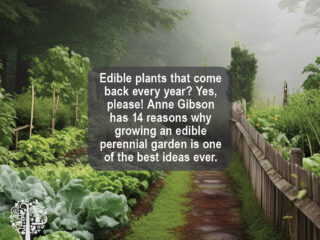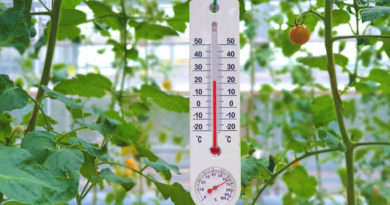14 Benefits of Growing an Edible Perennial Garden
I have great respect for perennial plants. After working with many species over the years, I compare perennials to the foundations of a house. They underpin a garden’s structure and form the basis of design elements in resilient, well-designed edible gardens.
The word ‘perennial’ originated from the Latin ‘perennis,’ meaning ‘throughout the years, and gives us a clue about their long-term value.
Edible perennials are always my starting point when planning a garden from scratch or redesigning a space. They provide long-lasting value and enjoyment and are essential to a sustainable food garden.


The Many Benefits of Perennial Crops
Long-Lived Enduring Nutritious Yields:
Perennial food crops have a great return on investment with a lifespan of at least two years but often decades, depending on the species. Plant once for long-term yields. For example, well-cared-for fruit and nut trees, like asparagus plants, can last decades. Passionfruit vines provide around five years of fruit. Berries re-shoot and fruit year after year, giving diverse nutrients for health. Some varieties, like mulberries, can’t be purchased in shops due to their short shelf-life. However, they produce kilos of fruit in a home garden and are best eaten fresh off the tree.
Sustainable Food Supply:
We live in uncertain times with disruptions to transport, fuel, and supermarket access during weather events. Skyrocketing food prices put pressure on the affordability of many fruits and vegetables. Edible perennial crops provide food sovereignty and security. Many perennial crops provide seeds to save and the ability to be self-reliant.
Time and Money Saving:
Once perennials are planted and established, you can focus on short-lived annual crops.
Extensive Root Systems:
Perennial fruit trees, vegetables, and herbs tend to have deeper, widespread roots. This advantage enables many to develop mutually beneficial relationships with mycorrhizal fungi and access nutrients efficiently for healthy growth. These root systems stabilize and improve soil structure, helping to reduce compaction while improving aeration. The roots also minimize potential erosion, enhance water-holding capacity, and expand the biodiversity of microorganism soil communities—an impressive contribution to soil health.
Dynamic Accumulators:
Some of my favorite perennials draw up specific minerals deep in the soil. For example, I use Stinging Nettle for its medicinal properties and herbal tea and make a liquid fertilizer from the leaves. It is a good source of calcium and potassium. Likewise, comfrey leaves return calcium, potassium and magnesium to the soil and make a nutrient-rich mulch or liquid food for plants.
Low Maintenance:
With some exceptions, most perennials require far less work than annuals. They can draw up minerals and moisture deep within the subsoil layers to survive longer without watering or feeding. Fruit trees and some edibles need pruning, but we don’t have to start from scratch each season.
Easy to Propagate:
Many perennials provide propagating material to expand your garden for free. For example, I take cuttings regularly from perennial basil, spinach and rosemary. Other edibles like capsicum, eggplant, and chillis give me free seeds. Clumping perennial herbs like chives can be divided as they touch the soil. This helps increase the number of plants I grow at no cost and with little effort.
Sizes to Suit all Gardens:
Many perennial fruit and nut tree cultivars are available in full-size and compact dwarf varieties. This enables gardeners to choose suitable species according to their space requirements. Numerous fruit trees are grafted onto dwarf rootstock, ideal for pots or renters who need smaller or portable plant options.
Shade Canopies:
Fruit trees, vines, and taller shrubs provide a vital shady microclimate role in the garden. The natural ‘umbrella’ a tree creates helps shade the soil and provide protection for sun-sensitive plants and a cool microclimate. Without these leafy shelters, birds, animals and plants wouldn’t survive in the garden for long. The branches and shade are places to retreat to in the heat, cold, storms, or heavy rain.
Habitat and Forage:
Most of my fruit trees and many edible shrubs provide a protective haven for birds of all sizes to nest. The flowers offer a sweet nectar reward to pollinators, predatory insects, and birds. These provide free pest management ecosystem services in the garden, reducing the need for chemical interventions. They contribute to a more biodiverse ecosystem in the garden.
Windbreaks:
Many of the edible perennials I grow are chosen for their multi-functional roles. For example, Queensland arrowroot, galangal, and feijoas help buffer the wind, reducing damage to other species. I often plant these in a guild to protect dwarf bananas or shelter shorter edibles.
Water Efficient or Drought Hardy:
Having been through several challenging droughts, I have had the opportunity to observe which edibles have been able to survive. Once their root systems are established, most perennial foods in my garden have been incredibly resilient. Some I rarely watered, and others didn’t need my help. Given the challenging climate conditions we are all experiencing, plants with low water needs are a significant advantage. Aloe vera, rosemary, garlic chives, eggplant and warragal greens are a few examples.
Store Soil Carbon:
As many edible perennials lose leaves or are pruned, this organic material builds soil health by adding carbon as it decomposes. Because perennials live longer, their root systems effectively stockpile carbon, acting like a warehouse for organic matter.
Diverse Color and Texture Palettes:
The diversity of colorful foliage, fruits and flowers, growth habits, and textures provide infinite opportunities to create unique gardens reflecting our tastes. For example, I love blues and purples. So I grow perennial edibles like blueberries, passionfruit, eggplant, grapes, and mulberries to add a splash of these colors throughout the garden. Their various leaf shapes and growing habits make them versatile and eye-catching as potager design elements.


Factors to Consider with Edible Perennials
- They need a permanent location: Think carefully about where you plant perennials. Moving a perennial tree or plant is much more complicated once established, as its root system is generally deep or expansive. Perennials develop their resilience to climactic conditions over time. They can seek out moisture and nutrients at a greater distance than short-stay shallow-rooted annuals.
- They take time to establish: Whereas annuals sprint out the gate and are typically ready for harvest in a relatively short time, perennial edibles can sometimes take years before they are mature for harvest. Consider planting perennials as soon as possible, especially fruit trees.
- Consider mature size when planting: Allow enough space for perennial species to mature. Sometimes, I’ve underestimated just how fast some would grow and how much personal space they have needed! There’s nothing worse than overcrowding, which can contribute to poor air circulation, encourage diseases and make harvesting difficult. Research before planting and allow sufficient room with a buffer!
- Some perennials need regular pruning: While most perennial varieties are low maintenance, many fruit trees and vines need ongoing attention to optimize their harvest and health. For example, citrus trees need shaping and decluttering. In some climates, grapes, passionfruit, and some berries will lose their leaves or die back, requiring a seasonal tidy-up.
- Choose perennial varieties of vegetables over annuals: Why plant annual leeks when a perennial variety will self-propagate into clumps for years? Over summer, growing salad greens in a warm or hot climate can be challenging. I swap to perennial options like sorrel, wild rocket, tree lettuce, dandelion, chicory, lemon balm and mint.
- Growing annuals as perennials: Depending on the climate, some edibles classed as annuals or biennials can grow for much longer. For example, in my subtropical climate, sweet basil has been growing consistently for over two years, as have my cherry tomatoes. I just never pulled them out! They like the position and soil and just keep growing. So, experiment and see what happens.
With so many benefits and uses, edible perennials are the obvious choice for enhancing our ability to live more sustainably with a resilient, productive garden for years to come.




